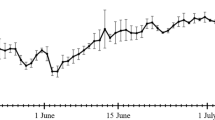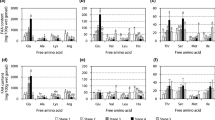Abstract
Hemicentrotus pulcherrimus in the Tohoku area is not utilized as a fishery product because the ovaries have a bitter taste almost all year. To discover the cause, we compared the annual reproductive cycles and ovarian accumulation of a bitter amino acid, pulcherrimine, in H. pulcherrimus collected at Mikuni (Fukui Prefecture), where it is fished in summer, and Iwaki (Fukushima Prefecture), where it is not utilized. At both sites, pulcherrimine increased in maturing ovaries as oogenesis proceeded from autumn to winter, decreased after spawning in spring, but remained in spent and immature ovaries for a few months. In Mikuni, pulcherrimine was scarcely detected in the ovaries for several months in summer. However, in Iwaki, late spawning delayed the disappearance of pulcherrimine in summer, and early initiation of oogenesis advanced the restart of pulcherrimine accumulation in autumn compared to Mikuni. Consequently, the period when the ovaries were palatable because of the absence of pulcherrimine during summer was short in Iwaki. The major cause of such short-term palatability could be the lower seawater temperature in the Tohoku area. Furthermore, pulcherrimine was never detected in other sea urchins, although a bitter taste was found in the mature ovaries of some species.




Similar content being viewed by others
References
Agatsuma Y (1992) Annual reproductive cycle of the sea urchin, Hemicentrotus pulcherrimus in southern Hokkaido. Suisanzoshoku 40:475–478 (in Japanese with English abstract)
Agatsuma Y (2013a) Strongylocentrotus nudus. In: Lawrence JM (ed) Sea urchins: biology and ecology, 3rd edn. Elsevier, Amsterdam, pp 449–460
Agatsuma Y (2013b) Hemicentrotus pulcherrimus, Pseudocentrotus depressus, and Heliocidaris crassispina. In: Lawrence JM (ed) Sea urchins: biology and ecology, 3rd edn. Elsevier, Amsterdam, pp 461–473
Agatsuma Y, Yamada H, Taniguchi K (2006) Distribution of the sea urchin Hemicentrotus pulcherrimus along a shallow bathymetric gradient in Onagawa Bay in northern Honshu, Japan. J Shellfish Res 25:1027–1036
Barker MF (2020) Evechinus chloroticus. In: Lawrence JM (ed) Sea urchins: biology and ecology, 3rd edn. Elsevier, Amsterdam, pp 355–368
Fuji A (1960) Studies on the biology of the sea urchin. I. Superficial and histological gonadal changes in gametogenic process of two sea urchins, Strongylocentrotus nudus and S. intermedius. Bull Fac Fish Hokkaido Univ 11:1–14
Imai T (1995) Studies on the sea urchin propagation in central Japan. Special Report of the Kanagawa Prefectural Fishery Experimental Station 6:90 (in Japanese with English abstract)
Ito S, Shibayama M, Kobayakawa A, Tani Y (1989) Promotion of maturation and spawning of sea urchin Hemicentrotus pulcherrimus by regulating water temperature. Nippon Suisan Gakkaishi 55:757–763 (in Japanese with English abstract)
Kawana T (1938) On the propagation of Strongylocentrotus pulcherrimus. Suisan Kenkyu Shi 33:104–116 (in Japanese)
Kobayashi N (1969) Spawning periodicity of sea urchins at Seto. III. Tripneustes gratilla, Echinometra mathaei, Anthocidaris crassispina and Echinostrephus aciculatus. The Science and Engineering Review of Doshisha University 9:254–269 (in Japanese with English abstract)
Kobayashi N (1992) Spawning periodicity of sea urchins at Seto Hemicentrotus pulcherrimus. P-SMBL 35:335–345
Kuroda H, Setou T, Kakehi S, Ito S, Taneda T, Azumaya T, Inagake D, Hiroe Y, Morinaga K, Okazaki M, Yokota T, Okunishi T, Aoki K, Shimizu Y, Hasegawa D, Watanabe T (2017) Recent advances in Japanese fisheries science in the Kuroshio-Oyashio region through development of the FRA-ROMS ocean forecast system: overview of the reproducibility of reanalysis products. OJMS 7:62–90
Masaki K, Kawahara I (1995) Promotion of gonadal maturation by regulating water temperature in the sea urchin Pseudocentrotus depressus - I. Bulletin of Saga Prefectural Sea Farming Center 4:93–100 (in Japanese)
Masuda R, Dan JC (1977) Studies on the annual reproductive cycle of the sea urchin and the acid phosphatase activity of relict ova. Biol Bull 153:577–590
Miwa K (1970) Studies on a freezing storage of sea urchins-I on pungent components in a frozen sea urchin gonad. Nippon Suisan Gakkaishi 36:617–622 (in Japanese with English abstract)
Murata Y, Sata UN (2000) Isolation and structure of pulcherrimine, a novel bitter-tasting amino acid, from the sea urchin (Hemicentrotus pulcherrimus) ovaries. J Agric Food Chem 48:5557–5560
Murata Y, Yamamoto T, Kaneniwa M, Kuwahara R, Yokoyama M (1998) Occurrence of bitter gonad in Hemicentrotus pulcherrimus. Nippon Suisan Gakkaishi 64:477–478 (in Japanese with English abstract)
Murata Y, Sakaguchi M, Sata UN, Kuwahara R, Kaneniwa M, Oohara I (2000) Bitterness of a novel sulfur-containing amino acid, pulcherrimine from the green sea urchin, Hemicentrotus pulcherrimus. Jpn J Taste Smell Res 7:615–618 (in Japanese with English abstract)
Murata Y, Sata NU, Yokoyama M, Kuwahara R, Kaneniwa M, Oohara I (2001) Determination of a novel bitter amino acid, pulcherrimine, in the gonad of the green sea urchin Hemicentrotus pulcherrimus. Fish Sci 67:341–345
Murata Y, Yokoyama M, Unuma T, Sata NU, Kuwahara R, Kaneniwa M (2002) Seasonal changes of bitterness and pulcherrimine content in gonads of green sea urchin Hemicentrotus pulcherrimus at Iwaki in Fukushima Prefecture. Fish Sci 68:184–189
Murata Y, Yoshimura H, Unuma T (2020) Compositions of extractive components in the testes and ovaries of various sea urchins: comparisons among species, sexes, and maturational status. Fish Sci 86:203–213
Onitsuka T, Kawamura T, Horii T, Takiguchi N, Takami H, Watanabe Y (2007) Synchronized spawning of abalone Haliotis diversicolor triggered by typhoon events in Sagami Bay, Japan. Mar Ecol Prog Ser 351:129–138
Osanai K (1975) Handling Japanese sea urchins and their embryos. In: Czihak G (ed) The sea urchin embryo: biochemistry and morphogenesis. Springer-Verlag, Berlin Heidelberg, pp 26–40
Saito K (2006) Seasonal variation in bitter substances of green sea urchin, with particular reference to its industrial utilization. Bull Fukushima Pref Fish Exp Stat 13:53–61 (in Japanese)
Sakai Y (2015) Hatchery technology (production of seed). In: Brown NP, Eddy SD (eds) Echinoderm Aquaculture. John Wiley & Sons Inc, Hoboken, pp 85–93
Sakairi K, Yamamoto M, Ohtsu K, Yoshida M (1989) Environmental control of gonadal maturation in laboratory-reared sea urchin, Anthocidaris crassispina and Hemicentrotus pulcherrimus. Zool Sci 6:721–730
Sata UN, Kuwahara R, Murata Y (2001) Synthesis of all isomers of pulcherrimine, a bitter principle in the sea urchin ovary. Tetrahedron Lett 42:115–118
Semura H (1991) Ecology of the sea urchin Hemicentrotus pulcherrimus off the central coast of Shimane Prefecture. Saibaigiken 19:67–74 (in Japanese)
Tominaga A, Takashima Y (1987) Ultra cytochemical study on the behavior of the nurse cell giant granules in the sea urchin ovary. Acta Histochem Cytochem 20:569–579
Unuma T (2015) Introduction: sea urchin fisheries in Japan. In: Brown NP, Eddy SD (eds) Echinoderm aquaculture. John Wiley & Sons Inc, Hoboken, pp 77–85
Unuma T, Kayaba T (2015) Land-based and captive sea-based grow out (cultivation of seed to market size). In: Brown NP, Eddy SD (eds) Echinoderm aquaculture. John Wiley & Sons Inc, Hoboken, pp 103–126
Unuma T, Walker CW (2009) Relationship between gametogenesis and food quality in sea urchin gonads. Proceedings of the 36th U.S.-Japan Aquaculture Panel Symposium. pp 45–54
Unuma T, Konishi K, Furuita H, Yamamoto T, Akiyama T (1996) Seasonal changes in gonads of cultured and wild red sea urchin, Pseudocentrotus depressus. Suisanzoshoku 44:169–175
Unuma T (2002) Gonadal growth and its relationship to aquaculture in sea urchins. In: Yokota Y et al (eds) The sea urchin: from basic biology to aquaculture. Swets & Zeitlinger, Lisse, pp 115–127
Unuma T, Ikeda K, Yamano K, Moriyama A, Ohta H (2007) Zinc-binding property of the major yolk protein in the sea urchin – implications of its role as a zinc transporter for gametogenesis. FEBS J 274(19):4985–4998
Unuma T, Murata Y, Hasegawa N, Sawaguchi S, Takahashi K (2015) Improving the food quality of sea urchins collected from barren grounds by short-term aquaculture under controlled temperature. Bull Fish Res Agen 40:145–153
Walker CW, Lesser MP, Unuma T (2020) Gametogenesis in regular sea urchins: structural, functional, and molecular/genomic biology. In: Lawrence JM (ed) Sea urchins: biology and ecology, 4th edn. Elsevier, Amsterdam, pp 29–50
Yamamoto M, Ishine M, Yoshida M (1988) Gonadal maturation independent of photic conditions in laboratory-reared sea urchins, Pseudocentrotus depressus and Hemicentrotus pulcherrimus. Zool Sci 5:979–988
Yamasaki M, Kiyomoto S (1993) Reproductive cycle of the sea urchin Anthocidaris crassispina from Hirado Island, Nagasaki Prefecture. Bull Seikai Natl Fish Res Inst 71:33–40 (in Japanese with English abstract)
Acknowledgements
We are grateful to Ken Nonaka at the Nagasaki Prefectural Institute of Fisheries, Tadamitsu Igari at the Kagoshima Prefectural Fisheries Technology and Development Center, Yasunobu Nakabayashi at the Akita Prefectual Institute of Fisheries, Katsumi Takanashi at Aomori Prefectural Aquaculture Research Center, Daichi Nakano and Koji Kodama at Fukui Prefectural Fisheries Experimental Station, for collecting wild sea urchins. We also thank Tomonori Azumaya at the Japan Fisheries Research and Education Agency for his help to estimate sea surface temperature at Mikuni and Iwaki, and Akemi Sakaguchi, and Hiroaki Saito at the former National Research Institute of Fisheries Science, and Ryuji Kuwahara at the Japan Fisheries and Education Agency, and Shin-Kwon Kim at the Tokyo University of Marine Science and Technology for technical assistance. A portion of this study was conducted as part of a research project ‘‘Research and Development Projects for Application in the New Policy of Agriculture, Forestry and Fisheries,’’ funded by the Ministry of Agriculture, Forestry and Fisheries, Japan. The remainder was financially supported by the Japan Fisheries Research and Education Agency.
Author information
Authors and Affiliations
Corresponding author
Additional information
Publisher's Note
Springer Nature remains neutral with regard to jurisdictional claims in published maps and institutional affiliations.
Rights and permissions
About this article
Cite this article
Murata, Y., Saito, K., Sugimoto, K. et al. Accumulation of a bitter amino acid, pulcherrimine, in sea urchin ovaries and its relevance to the annual reproductive cycle. Fish Sci 87, 371–381 (2021). https://doi.org/10.1007/s12562-021-01496-8
Received:
Accepted:
Published:
Issue Date:
DOI: https://doi.org/10.1007/s12562-021-01496-8




